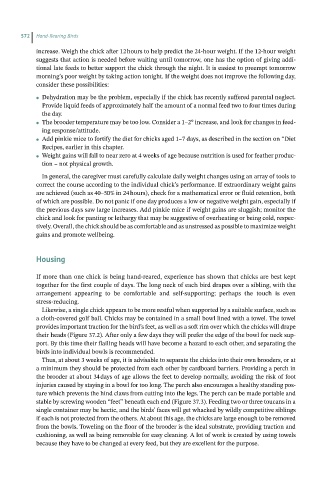Page 571 - Hand rearing birds second
P. 571
572 Hand-Rearing Birds
increase. Weigh the chick after 12 hours to help predict the 24‐hour weight. If the 12‐hour weight
suggests that action is needed before waiting until tomorrow, one has the option of giving addi-
tional late feeds to better support the chick through the night. It is easiest to preempt tomorrow
morning’s poor weight by taking action tonight. If the weight does not improve the following day,
consider these possibilities:
Dehydration may be the problem, especially if the chick has recently suffered parental neglect.
●
Provide liquid feeds of approximately half the amount of a normal feed two to four times during
the day.
The brooder temperature may be too low. Consider a 1–2° increase, and look for changes in feed-
●
ing response/attitude.
Add pinkie mice to fortify the diet for chicks aged 1–7 days, as described in the section on “Diet
●
Recipes, earlier in this chapter.
Weight gains will fall to near zero at 4 weeks of age because nutrition is used for feather produc-
●
tion – not physical growth.
In general, the caregiver must carefully calculate daily weight changes using an array of tools to
correct the course according to the individual chick’s performance. If extraordinary weight gains
are achieved (such as 40–50% in 24 hours), check for a mathematical error or fluid retention, both
of which are possible. Do not panic if one day produces a low or negative weight gain, especially if
the previous days saw large increases. Add pinkie mice if weight gains are sluggish; monitor the
chick and look for panting or lethargy that may be suggestive of overheating or being cold, respec-
tively. Overall, the chick should be as comfortable and as unstressed as possible to maximize weight
gains and promote wellbeing.
Housing
If more than one chick is being hand‐reared, experience has shown that chicks are best kept
together for the first couple of days. The long neck of each bird drapes over a sibling, with the
arrangement appearing to be comfortable and self‐supporting; perhaps the touch is even
stress‐reducing.
Likewise, a single chick appears to be more restful when supported by a suitable surface, such as
a cloth‐covered golf ball. Chicks may be contained in a small bowl lined with a towel. The towel
provides important traction for the bird’s feet, as well as a soft rim over which the chicks will drape
their heads (Figure 37.2). After only a few days they will prefer the edge of the bowl for neck sup-
port. By this time their flailing heads will have become a hazard to each other, and separating the
birds into individual bowls is recommended.
Thus, at about 3 weeks of age, it is advisable to separate the chicks into their own brooders, or at
a minimum they should be protected from each other by cardboard barriers. Providing a perch in
the brooder at about 34 days of age allows the feet to develop normally, avoiding the risk of foot
injuries caused by staying in a bowl for too long. The perch also encourages a healthy standing pos-
ture which prevents the hind claws from cutting into the legs. The perch can be made portable and
stable by screwing wooden “feet” beneath each end (Figure 37.3). Feeding two or three toucans in a
single container may be hectic, and the birds’ faces will get whacked by wildly competitive siblings
if each is not protected from the others. At about this age, the chicks are large enough to be removed
from the bowls. Toweling on the floor of the brooder is the ideal substrate, providing traction and
cushioning, as well as being removable for easy cleaning. A lot of work is created by using towels
because they have to be changed at every feed, but they are excellent for the purpose.

